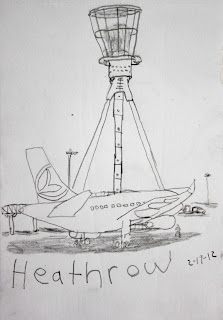 |
| Isa Genzken |
When in london this past week I visited the acclaimed Saatchi Gallery. The Gallery is actually the wrong word to describe it... its much more like a museum. The location and the architecture is wonderful. Its the kind of space I wish SF MOMA had... spacious, fun to walk through, lots of natural light, and very open feeling. However, the art in Saatchi didn't compare to the space. In general it came off as so much trendy art work does, as cheap and under developed. It was a bit like an MFA show at Hunter College... too self consciously artsy, as if they were pandering to an over-art-educated audience. Simultaneously the art also came off as something that grade school students would expect art to look like. Its hard to explain, but you know, its like an elementary art class where kids are splashing paint around, cutting up cardboard, and gluing random things together. Don't get me wrong, it's lovely when you see kids working this way... but when I see adult artists doing this kind of stuff I can't help but to think that they've been duped in art school and had attained some career success to early for the success of their art.
 |
| Georg Herold |
My reaction to Andre Butzer's work and Isa Genzken's work represents my feelings as a whole about the art at Saachi. Both bodies of work lacked depth and looked too cheap and too random for me to properly enter into it. Some work didn't seem to be in the right place; Jeppe Hein's work and Zhivago Duncan's work should both be touring with a circus and Georg Herold sculptures would be better suited for the outside of FIT or in the lobby of some other Fashion Art School.
 |
| Thomas Zipp |
On a positive note, I spent the most time looking at Thomas Zipp's work. His exhibition was organized well... it had sculpture, installation, and painting. The sculptural elements were great fun to walk around and touch with your eyes, while his portrait paintings were moving, and his drawings hung on the walls of his installation were imaginative, simple, and interesting. Thomas Kiesewetter's metal sculptures were well done. Max Frisinger's work presented an interesting way to make sculpture 2-dementional. However... the best work in the show was done by a 15 year old as part of their School Prize exhibition. And unfortunately I must confess that I seemed to have missed Richard Wilson's 20:50 which I am ashamed of. It seems like a great work of art from what I hear.
 |
| James Wallis |
Overall, Saatchi Gallery was yet another example of a very powerful gallery exhibiting work that "stinks of art". Sure, Damien Hirst's work "stinks of art" too, but thats what Damien's art is all about, and his stench is deliberate. The artists at Saatchi this time around didn't know their art "stinks of art"... and sometimes, especially in the contemporary world of art, "knowing is half the battle". Congrats James Wallis!























